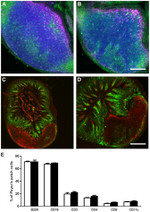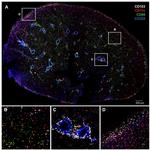Product References
Targeted inhibition of osteoclastogenesis reveals the pathogenesis and therapeutics of bone loss under sympathetic neurostress.
International journal of oral science
Sui B,Liu J,Zheng C,Dang L,Chen J,Cao Y,Zhang K,Liu L,Dang M,Zhang L,Chen N,He T,Xuan K,Jin F,Zhang G,Jin Y,Hu C
Published figure using CD11c monoclonal antibody (Product # 42-0114-82) in Immunohistochemistry
Mon Aug 01 00:00:00 EDT 2022
Self-Tolerance of Vascular Tissues Is Broken Down by Vascular Dendritic Cells in Response to Systemic Inflammation to Initiate Regional Autoinflammation.
Frontiers in immunology
Sun L,Zhang W,Zhao L,Zhao Y,Wang F,Lew AM,Xu Y
Published figure using CD11c monoclonal antibody (Product # 42-0114-82) in Immunohistochemistry
Fri Apr 01 00:00:00 EDT 2022
Single-cell transcriptomics reveals distinct cell response between acute and chronic pulmonary infection of Pseudomonas aeruginosa.
MedComm
Hu X,Wu M,Ma T,Zhang Y,Zou C,Wang R,Zhang Y,Ren Y,Li Q,Liu H,Li H,Wang T,Sun X,Yang Y,Tang M,Li X,Li J,Gao X,Li T,Zhou X
Published figure using CD11c monoclonal antibody (Product # 42-0114-82) in Immunohistochemistry
Thu Dec 01 00:00:00 EST 2022
Neutrophil-specific gain-of-function mutations in Nlrp3 promote development of cryopyrin-associated periodic syndrome.
The Journal of experimental medicine
Stackowicz J,Gaudenzio N,Serhan N,Conde E,Godon O,Marichal T,Starkl P,Balbino B,Roers A,Bruhns P,Jönsson F,Moguelet P,Georgin-Lavialle S,Broderick L,Hoffman HM,Galli SJ,Reber LL
Published figure using CD11c monoclonal antibody (Product # 42-0114-82) in Immunohistochemistry
Mon Oct 04 00:00:00 EDT 2021
Depletion of Adipocyte Becn1 Leads to Lipodystrophy and Metabolic Dysregulation.
Diabetes
Jin Y,Ji Y,Song Y,Choe SS,Jeon YG,Na H,Nam TW,Kim HJ,Nahmgoong H,Kim SM,Kim JW,Nam KT,Seong JK,Hwang D,Park CB,Lee IH,Kim JB,Lee HW
Published figure using CD11c monoclonal antibody (Product # 42-0114-82) in Immunohistochemistry
Fri Jan 01 00:00:00 EST 2021
Enrichment of Neurodegenerative Microglia Signature in Brain-Derived Extracellular Vesicles Isolated from Alzheimer's Disease Mouse Models.
Journal of proteome research
Muraoka S,Jedrychowski MP,Iwahara N,Abdullah M,Onos KD,Keezer KJ,Hu J,Ikezu S,Howell GR,Gygi SP,Ikezu T
Published figure using CD11c monoclonal antibody (Product # 42-0114-82) in Western Blot
Fri Mar 05 00:00:00 EST 2021
Dual-Wavelength Photosensitive Nano-in-Micro Scaffold Regulates Innate and Adaptive Immune Responses for Osteogenesis.
Nano-micro letters
Zhao Q,Shi M,Yin C,Zhao Z,Zhang J,Wang J,Shen K,Zhang L,Tang H,Xiao Y,Zhang Y
Published figure using CD11c monoclonal antibody (Product # 42-0114-82) in Immunohistochemistry
Sat Nov 21 00:00:00 EST 2020
Glufosinate constrains synchronous and metachronous metastasis by promoting anti-tumor macrophages.
EMBO molecular medicine
Menga A,Serra M,Todisco S,Riera-Domingo C,Ammarah U,Ehling M,Palmieri EM,Di Noia MA,Gissi R,Favia M,Pierri CL,Porporato PE,Castegna A,Mazzone M
Published figure using CD11c monoclonal antibody (Product # 42-0114-82) in Immunohistochemistry
Wed Oct 07 00:00:00 EDT 2020
Endothelial-to-mesenchymal transition compromises vascular integrity to induce Myc-mediated metabolic reprogramming in kidney fibrosis.
Science signaling
Lovisa S,Fletcher-Sananikone E,Sugimoto H,Hensel J,Lahiri S,Hertig A,Taduri G,Lawson E,Dewar R,Revuelta I,Kato N,Wu CJ,Bassett RL,Putluri N,Zeisberg M,Zeisberg EM,LeBleu VS,Kalluri R
42-0114 was used in Flow cytometry/Cell sorting to demonstrate a functional role for EndMT in the response to kidney capillary endothelial injury and highlight the contribution of endothelial-epithelial cross-talk in the development of kidney fibrosis with a potential for therapeutic intervention.
Tue Jun 09 00:00:00 EDT 2020
Combined antiangiogenic and anti-PD-L1 therapy stimulates tumor immunity through HEV formation.
Science translational medicine
Allen E,Jabouille A,Rivera LB,Lodewijckx I,Missiaen R,Steri V,Feyen K,Tawney J,Hanahan D,Michael IP,Bergers G
Published figure using CD11c monoclonal antibody (Product # 42-0114-82) in Immunofluorescence
Wed Apr 12 00:00:00 EDT 2017
Identification of different macrophage subpopulations with distinct activities in a mouse model of oxygen-induced retinopathy.
International journal of molecular medicine
Zhu Y,Zhang L,Lu Q,Gao Y,Cai Y,Sui A,Su T,Shen X,Xie B
Published figure using CD11c monoclonal antibody (Product # 42-0114-82) in Immunofluorescence
Tue Aug 01 00:00:00 EDT 2017
PEDF mediates pathological neovascularization by regulating macrophage recruitment and polarization in the mouse model of oxygen-induced retinopathy.
Scientific reports
Gao S,Li C,Zhu Y,Wang Y,Sui A,Zhong Y,Xie B,Shen X
Published figure using CD11c monoclonal antibody (Product # 42-0114-82) in Immunofluorescence
Fri Feb 17 00:00:00 EST 2017
CD11c+ resident macrophages drive hepatocyte death-triggered liver fibrosis in a murine model of nonalcoholic steatohepatitis.
JCI insight
Itoh M,Suganami T,Kato H,Kanai S,Shirakawa I,Sakai T,Goto T,Asakawa M,Hidaka I,Sakugawa H,Ohnishi K,Komohara Y,Asano K,Sakaida I,Tanaka M,Ogawa Y
Published figure using CD11c monoclonal antibody (Product # 42-0114-82) in Immunohistochemistry
Thu Nov 16 00:00:00 EST 2017
Precision-cut Mouse Lung Slices to Visualize Live Pulmonary Dendritic Cells.
Journal of visualized experiments : JoVE
Lyons-Cohen MR,Thomas SY,Cook DN,Nakano H
Published figure using CD11c monoclonal antibody (Product # 42-0114-82) in Immunofluorescence
Wed Apr 05 00:00:00 EDT 2017
Identification of a Hematopoietic Cell Dedifferentiation-Inducing Factor.
Journal of cellular physiology
Li Y,Adomat H,Guns ET,Hojabrpour P,Duronio V,Curran TA,Jalili RB,Jia W,Delwar Z,Zhang Y,Elizei SS,Ghahary A
Published figure using CD11c monoclonal antibody (Product # 42-0114-82) in Immunocytochemistry
Wed Jun 01 00:00:00 EDT 2016
Flagellin is a strong vaginal adjuvant of a therapeutic vaccine for genital cancer.
Oncoimmunology
Lee SE,Hong SH,Verma V,Lee YS,Duong TN,Jeong K,Uthaman S,Sung YC,Lee JT,Park IK,Min JJ,Rhee JH
Published figure using CD11c monoclonal antibody (Product # 42-0114-82) in Immunofluorescence
Mon Feb 01 00:00:00 EST 2016
Antigen presenting cell abnormalities in the Cln3(-/-) mouse model of juvenile neuronal ceroid lipofuscinosis.
Biochimica et biophysica acta
Hersrud SL,Kovács AD,Pearce DA
Published figure using CD11c monoclonal antibody (Product # 42-0114-82) in Immunocytochemistry
Fri Jul 01 00:00:00 EDT 2016
M cell-derived vesicles suggest a unique pathway for trans-epithelial antigen delivery.
Tissue barriers
Sakhon OS,Ross B,Gusti V,Pham AJ,Vu K,Lo DD
Published figure using CD11c monoclonal antibody (Product # 42-0114-82) in Immunofluorescence
Fri Apr 03 00:00:00 EDT 2015
Immune complexes stimulate CCR7-dependent dendritic cell migration to lymph nodes.
Nature medicine
Clatworthy MR,Aronin CE,Mathews RJ,Morgan NY,Smith KG,Germain RN
Published figure using CD11c monoclonal antibody (Product # 42-0114-82) in Immunofluorescence
Mon Dec 01 00:00:00 EST 2014
Sessile alveolar macrophages communicate with alveolar epithelium to modulate immunity.
Nature
Westphalen K,Gusarova GA,Islam MN,Subramanian M,Cohen TS,Prince AS,Bhattacharya J
Published figure using CD11c monoclonal antibody (Product # 42-0114-82) in Immunofluorescence
Thu Feb 27 00:00:00 EST 2014
Mice deficient in intestinal epithelium cytochrome P450 reductase are prone to acute toxin-induced mucosal damage.
Scientific reports
Ahlawat S,Xie F,Zhu Y,D'Hondt R,Ding X,Zhang QY,Mantis NJ
Published figure using CD11c monoclonal antibody (Product # 42-0114-82) in Immunofluorescence
Thu Jul 03 00:00:00 EDT 2014
Invariant natural killer T cells regulate anti-tumor immunity by controlling the population of dendritic cells in tumor and draining lymph nodes.
Journal for immunotherapy of cancer
Pilones KA,Aryankalayil J,Babb JS,Demaria S
42-0114 was used in Immunohistochemistry to demonstrate that iNKT cells limit priming of anti-tumor T-cells by controlling dendritic cells in tumors and draining lymph nodes.
Tue Oct 28 00:00:00 EDT 2014
CX(3)CR1(+) macrophages support IL-22 production by innate lymphoid cells during infection with Citrobacter rodentium.
Mucosal immunology
Manta C,Heupel E,Radulovic K,Rossini V,Garbi N,Riedel CU,Niess JH
Published figure using CD11c monoclonal antibody (Product # 42-0114-82) in Miscellaneous
Tue Jan 01 00:00:00 EST 2013
Hepatic crown-like structure: a unique histological feature in non-alcoholic steatohepatitis in mice and humans.
PloS one
Itoh M,Kato H,Suganami T,Konuma K,Marumoto Y,Terai S,Sakugawa H,Kanai S,Hamaguchi M,Fukaishi T,Aoe S,Akiyoshi K,Komohara Y,Takeya M,Sakaida I,Ogawa Y
Published figure using CD11c monoclonal antibody (Product # 42-0114-82) in Immunofluorescence
Sun Oct 12 00:00:00 EDT 2014
Depletion of B2 but not B1a B cells in BAFF receptor-deficient ApoE mice attenuates atherosclerosis by potently ameliorating arterial inflammation.
PloS one
Kyaw T,Tay C,Hosseini H,Kanellakis P,Gadowski T,MacKay F,Tipping P,Bobik A,Toh BH
Published figure using CD11c monoclonal antibody (Product # 42-0114-82) in Immunohistochemistry
Mon May 14 00:00:00 EDT 2012
Attenuation of AD-like neuropathology by harnessing peripheral immune cells: local elevation of IL-10 and MMP-9.
Journal of neurochemistry
Koronyo-Hamaoui M,Ko MK,Koronyo Y,Azoulay D,Seksenyan A,Kunis G,Pham M,Bakhsheshian J,Rogeri P,Black KL,Farkas DL,Schwartz M
Published figure using CD11c monoclonal antibody (Product # 42-0114-82) in Immunofluorescence
Tue Dec 01 00:00:00 EST 2009
Leptin receptor is expressed in thymus medulla and leptin protects against thymic remodeling during endotoxemia-induced thymus involution.
The Journal of endocrinology
Gruver AL,Ventevogel MS,Sempowski GD
Published figure using CD11c monoclonal antibody (Product # 42-0114-82) in Immunofluorescence
Thu Oct 01 00:00:00 EDT 2009
Dynamics of lung macrophage activation in response to helminth infection.
Journal of leukocyte biology
Siracusa MC,Reece JJ,Urban JF,Scott AL
Published figure using CD11c monoclonal antibody (Product # 42-0114-82) in Immunofluorescence
Mon Dec 01 00:00:00 EST 2008
Essential roles of DC-derived IL-15 as a mediator of inflammatory responses in vivo.
The Journal of experimental medicine
Ohteki T,Tada H,Ishida K,Sato T,Maki C,Yamada T,Hamuro J,Koyasu S
Mon Oct 02 00:00:00 EDT 2006
Essential roles of DC-derived IL-15 as a mediator of inflammatory responses in vivo.
The Journal of experimental medicine
Ohteki T,Tada H,Ishida K,Sato T,Maki C,Yamada T,Hamuro J,Koyasu S
Mon Oct 02 00:00:00 EDT 2006
The existence of CD11c+ sentinel and F4/80+ interstitial dendritic cells in dental pulp and their dynamics and functional properties.
International immunology
Zhang J,Kawashima N,Suda H,Nakano Y,Takano Y,Azuma M
Fri Sep 01 00:00:00 EDT 2006
Redirecting in vivo elicited tumor infiltrating macrophages and dendritic cells towards tumor rejection.
Cancer research
Guiducci C,Vicari AP,Sangaletti S,Trinchieri G,Colombo MP
Fri Apr 15 00:00:00 EDT 2005
![]() integrin
integrin




































